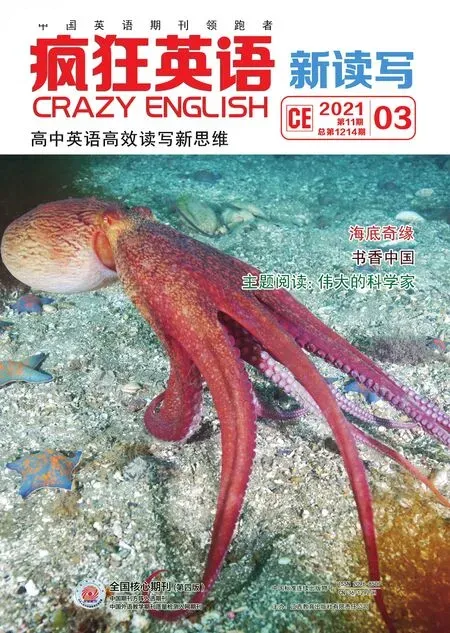海鲜中惊现塑料废物
浙江 张 芬
根据最新发现,海洋生物体内存在大量的塑料颗粒。因此,对于广大海鲜爱好者来说,他们在享用美味海鲜的同时,无疑也食用了很多微型塑料颗粒。
难词探意
1. edible /΄edəbl/ adj. 可食用的
2. debris /΄debriː/ n. 碎片;残骸
3. organism /΄ɔːɡənɪzəm/ n. 微生物
A team of University of Queensland researchers,led by PhD candidate Francisca Ribeiro found that significant amounts of microplastics had been found in a range of edible seafood such as sardines (沙丁鱼),oysters (牡蛎), prawns (对虾) and crabs. Microplastics are extremely small pieces of plastic debris in the environment that result from the breakdown of commercial plastic and industrial waste.
According to the researchers, the study was an important step in understanding how human health could be affected by microplastics in seafood. Among the samples, the most common plastic in use was found in high levels of concentration. From the edible marine species tested, sardines had the highest plastic content, which was a surprising result.
Another interesting aspect was the diversity of microplastic types found among species, with polyethylene (聚乙烯) mainly existing in fish and polyvinyl chloride (聚氯乙烯) the only plastic found in oysters. The research team found that the total plastic concentration detected in each species was: 0.04 mg in prawns, 0.1 mg in oysters, 0.3 mg in crabs, and 2.9 mg in sardines.

Microplastics are very small pieces of plastic that pollute marine environment, and are eaten by a range of organisms, from planktonic (浮游的) organisms to large marine animals. Studies show that microplastics can also enter a human diet from bottled water, sea salt, beer, honey, and dust left to settle on meals.
The method developed and used by the research team is a major step forward in being able to measure the amount of plastic in seafood, as it allows the results to be reported in a mass unit, which hasn't been done before. “We can now make sure what microplastic levels can be considered harmful to human health,” Ms Ribeiro said.
The next step of the research project is to check the sources of the plastic pollution found in the seafood tested.
1. What's the main effect of the new research?
A. It can help to protect the ocean from being polluted.
B. It can give advice to people on how to select seafood.
C. It can help to figure out how microplastics affect men.
D. It can make us realize the importance of reducing plastics.
2. Which sea animals contain the least plastic content?
A. Prawns. B. Oysters.
C. Crabs. D. Sardines.
3. What do researchers intend to do next?
A. To test the seafood on a large scale.
B. To find out the cause of plastic pollution.
C. To figure out the levels of microplastics.
D. To examine the roots of the plastic pollution.
4. Which column of a newspaper is the text probably taken from?
A. Diet. B. Life.
C. Science. D. Environment.
Sentence for writing
Another interesting aspect was the diversity of microplastic types found among species, with polyethylene mainly existing in fish and polyvinyl chloride the only plastic found in oysters.
【信息提取】句中的with polyethylene mainly existing in fish构成with的复合结构。
【句式仿写】随着嫦娥五号成功升入太空,我们都感到非常兴奋。

